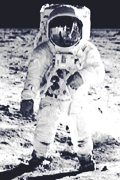Mooning NASA
After 27 years, Soquel author Bill Kaysing still insists the lunar landing was a hoax
By Rafer Guzmán
TWENTY SEVEN years ago last Saturday, the world watched as Neil Armstrong kicked up clouds of lunar dust and announced, "That's one small step for man, one giant leap for mankind."
At the time, Bill Kaysing had already finished a seven-year stint as a technical editor at Rocketdyne. Yet, he chose not to watch the televised landing. In Kaysing's words, "I could not generate the least enthusiasm for watching a phony performance."
So begins Kaysing's self-published book, We Never Went to the Moon. A far cry from Tom Wolfe's The Right Stuff, Kaysing's tract documents what he claims is the greatest hoax in history.
"I really believe that the body of evidence proves, beyond any doubt, that no way could we have gotten to the moon," Kaysing says from his trailer home in Soquel. "The technology did not exist in 1969, and it certainly doesn't exist today."
The 74 year-old author of several travel and lifestyle books has spent the last two decades researching his subject. His files include old issues of National Geographic, newspaper clippings, a 1970 survey claiming that 30 percent of Americans doubted the moon landings and material from like-minded skeptics in Germany, Holland and New Jersey. "It's been a labor of love for me," he says.
Kaysing's theory posits that the failure-prone NASA panicked when President John F. Kennedy foolishly announced that America would put a man on the moon by the decade's end. NASA continued with the actual Apollo missions, but their backup plan was the clandestine Apollo Simulation Project. Unable to make good on Kennedy's promise by 1969, NASA opted to go forward with the project.
The phony footage, he contends, was shot at Norton Air Force Base in San Bernardino. "They had more equipment and better equipment than all the movie studios in Hollywood combined," explains Kaysing, adding that the man in charge was none other than reclusive auteur Stanley Kubrick, whose 1968 epic 2001: A Space Odyssey impressed NASA officials. "He had access to everybody, globally," Kaysing maintains.
Kubrick did not respond by press time to questions faxed to his office.
Along with the "live" footage, NASA produced still photographs. After painstaking examination of these photos, Kaysing concluded that they were not taken on the moon. He holds up the famous pictures of the lunar landscape. "No stars," he says simply. "Standing on the moon and looking up at the heavens would be like standing on Mount Whitney on a clear night and seeing billions of stars right out to the horizon."
But in all the photos, the firmament is completely black. "That, to me, is the strongest evidence."
Then there is the Lunar Module, or LM, in which the astronauts landed on the moon's dusty surface. "I've witnessed hundreds of rocket firings," Kaysing says, "and it's incredible, the amount of heat and force which comes out."
Kaysing points to the LM's large jet-nozzle. "The temperature of that jet is 5,000 degrees Fahrenheit," he says. "It would have actually melted the dust into glass. There would have been an enormous crater." Yet the dust beneath the LM appears completely undisturbed.
Last June, Kaysing went to the San Jose Convention Center, where astronaut James Lovell was speaking. Kaysing presented Lovell with a copy of his book. "He was very jocular," remarks Kaysing.
But Lovell, after reading the book, sent an indignant letter to Kaysing insisting, "I personally made two trips to the moon. ... You heard my speech, and I am not accustomed to making up stories for my audience."
Speaking from his office in Illinois, Lovell said of Kaysing: "The guy is wacky. His position makes me feel angry. We spent a lot of time getting ready to go to the moon. We spent a lot of money, we took great risks, and it's something everybody in this country should be proud of. His problem is, he saw that movie Capricorn One and now he thinks that's really the way it goes."
Kaysing considers Lovell almost a comedian. "He's essentially a sort of comic Manchurian Candidate," he says. "He's been either brainwashed, hypnotized, programmed or whatever to present this spurious story of having gone to the moon."
Regarding Capricorn One, Kaysing claims that writer-director Peter Hyams based the 1978 film on his book. The script's copyright date was somehow changed, Kaysing says, to prevent him from suing.
The extent of the cover-up does not surprise Kaysing, who intends to take his theories to the grave. "Nothing could convince me now," he says. "You couldn't show me a thing."
[ Metro | Metroactive Central | Archives ]
This page was designed and created by the Boulevards team.

Starless Gazing: Noting the absence of stars in the background, Bill Kaysing thinks NASA's lunar photos were not taken on the moon.
From the July 25-31, 1996 issue of Metro
Copyright © 1996 Metro Publishing and Virtual Valley, Inc.
